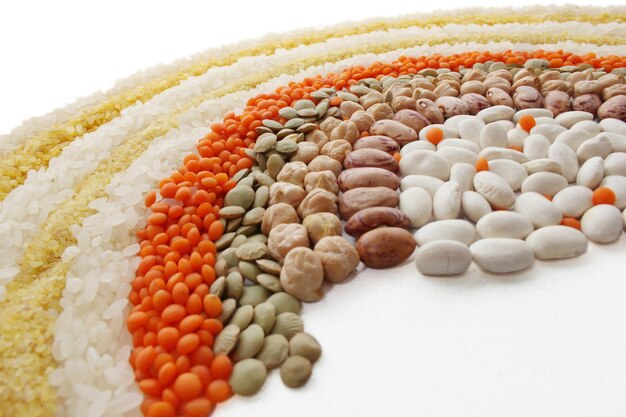Plant-Based vs Animal Protein: Optimize Muscle & Health?

Plant-based protein and animal protein both support muscle growth and overall health, but they differ significantly in their nutritional profiles, environmental impacts, and digestibility, making the “better” choice dependent on individual needs and preferences.
Navigating the world of nutrition can be overwhelming, especially when it comes to protein sources. You’ve likely heard about both plant-based and animal proteins, but which one truly reigns supreme for muscle growth and overall health? Let’s dive into the plant-based protein vs. animal protein: which is better for muscle growth and overall health?
Understanding Protein and Its Importance
Protein is essential for building and repairing tissues, producing enzymes and hormones, and supporting overall bodily functions. But what exactly makes up a protein, and why do we need it?
Proteins are made up of amino acids, which are often referred to as the building blocks of life. There are 20 different amino acids, nine of which are considered essential. Essential amino acids cannot be produced by the body and must be obtained through diet.
Why is Protein Important?
Protein plays a critical role in various bodily functions, including:
- Muscle growth and repair: Protein is crucial for repairing and rebuilding muscle tissue after exercise.
- Enzyme and hormone production: Many enzymes and hormones, responsible for countless biological processes, are made of protein.
- Immune function: Antibodies, which help fight off infections, are proteins.
Getting enough protein is vital, but the source of that protein can matter just as much.
In conclusion, protein is a fundamental nutrient, and understanding its importance is the first step in making informed dietary choices for muscle growth and overall health.

Animal Protein: A Comprehensive Overview
Animal protein sources have long been a staple in many diets, known for their high protein content and complete amino acid profiles. But what are the specific benefits and drawbacks of relying primarily on animal protein?
Animal proteins are derived from animals and include sources like meat (beef, chicken, pork), fish, eggs, and dairy products. These sources are generally considered complete proteins, meaning they contain all nine essential amino acids in sufficient quantities.
Benefits of Animal Protein
There are several reasons why animal protein has been a preferred choice for many individuals:
- Complete protein source: Animal proteins provide all essential amino acids in one convenient package.
- High bioavailability: The body can easily absorb and utilize the amino acids from animal sources.
- Rich in nutrients: Animal products often contain other essential nutrients like vitamin B12, iron, and zinc.
Potential Drawbacks
However, there are also potential downsides to consider:
- High in saturated fat: Many animal products are high in saturated fat, which can contribute to heart disease.
- Environmental impact: Animal agriculture has a significant environmental footprint, contributing to greenhouse gas emissions and deforestation.
- Digestive issues: Some individuals may experience digestive discomfort from consuming large amounts of animal protein.
Ultimately, animal protein can be a valuable part of a balanced diet, but it’s essential to consider the source and quantity to minimize potential health and environmental impacts.
In summary, animal protein offers convenience and a complete amino acid profile, but it’s crucial to be mindful of its saturated fat content and environmental implications.
Plant-Based Protein: A Nutrient-Rich Alternative
Plant-based protein sources have gained significant popularity as individuals seek sustainable and health-conscious dietary options. These sources not only provide protein but also offer a variety of other nutrients and health benefits.
Plant-based proteins come from various sources like legumes (beans, lentils, peas), grains (quinoa, brown rice), nuts, seeds, and soy products (tofu, tempeh, edamame).

Advantages of Plant-Based Protein
There are several compelling reasons to incorporate plant-based proteins into your diet:
- Rich in fiber: Plant-based proteins are often high in fiber, which promotes digestive health and helps regulate blood sugar levels.
- Lower in saturated fat: Compared to many animal products, plant-based proteins are typically lower in saturated fat.
- Environmentally sustainable: Plant-based agriculture generally has a smaller environmental footprint than animal agriculture.
Considerations for Plant-Based Protein
While plant-based proteins offer numerous benefits, there are a few factors to keep in mind:
- Incomplete protein profiles: Many plant-based proteins are incomplete, meaning they don’t contain all nine essential amino acids in sufficient amounts. However, eating a variety of plant-based proteins throughout the day can ensure you get all the essential amino acids you need.
- Lower bioavailability: Some plant-based proteins may be less easily absorbed by the body compared to animal proteins.
- Potential for digestive issues: Some individuals may experience gas or bloating when consuming large amounts of legumes or other high-fiber plant-based proteins.
Overall, plant-based proteins are a diverse and nutritious option, offering a range of health and environmental benefits. With careful planning, they can easily meet your protein needs.
In conclusion, plant-based proteins offer a sustainable and health-conscious alternative, rich in fiber and lower in saturated fat, but require strategic planning to ensure a complete amino acid intake.
Comparing Amino Acid Profiles
When evaluating protein sources, the amino acid profile is a critical factor. While animal proteins are typically complete, plant-based proteins often require strategic combinations to ensure all essential amino acids are adequately consumed.
Amino acids are the building blocks of protein, and the nine essential amino acids (histidine, isoleucine, leucine, lysine, methionine, phenylalanine, threonine, tryptophan, and valine) must be obtained through diet. A complete protein contains all nine of these amino acids in sufficient quantities.
Essential Amino Acids in Animal Protein
Animal proteins are generally considered complete proteins because they contain all nine essential amino acids. This makes them a convenient option for those looking to meet their protein needs efficiently.
Essential Amino Acids in Plant Protein
Many plant-based proteins are incomplete, meaning they are low in one or more essential amino acids. For example, legumes are often low in methionine, while grains are often low in lysine. However, by combining different plant-based proteins, you can create a complete protein profile.
Complementary proteins are two or more incomplete protein sources that, when eaten together, provide all nine essential amino acids. Examples include:
- Beans and rice
- Peanut butter and whole-wheat bread
- Lentils and quinoa
It’s not necessary to consume complementary proteins in the same meal; as long as you eat a variety of plant-based proteins throughout the day, you can meet your amino acid needs.
In short, while animal proteins offer a complete amino acid profile, combining various plant-based sources can also provide all essential amino acids, ensuring a balanced and nutritious diet.
In summary, while plant-based proteins might require a bit more planning, they can provide a complete amino acid profile through strategic food combinations, supporting overall health and muscle growth.
Impact on Muscle Growth
Protein is vital for muscle growth and repair, but the source of protein can influence how effectively it supports muscle development. Both animal and plant-based proteins can contribute to muscle growth, but there are key differences to consider.
Muscle protein synthesis (MPS) is the process by which the body repairs and builds muscle tissue. Consuming protein, especially after exercise, stimulates MPS, leading to muscle growth over time.
Animal Protein and Muscle Growth
Animal proteins are often favored for muscle growth due to their complete amino acid profiles and high bioavailability. Leucine, in particular, plays a significant role in stimulating MPS, and animal proteins tend to be rich in leucine.
Plant Protein and Muscle Growth
Plant-based proteins can also effectively support muscle growth, although they may require a bit more attention to amino acid intake. By consuming a variety of plant-based proteins, you can ensure you’re getting enough leucine and other essential amino acids to stimulate MPS.
Studies have shown that individuals following a well-planned plant-based diet can achieve similar muscle growth compared to those consuming animal protein. The key is to ensure adequate protein intake and a balanced amino acid profile.
Ultimately, both animal and plant-based proteins can support muscle growth, but plant-based options may require more strategic planning to ensure complete amino acid intake.
In essence, plant-based proteins can effectively support muscle growth if carefully planned to ensure sufficient leucine and a balanced intake of essential amino acids, challenging the notion that animal protein is the only option for muscle development.
Health Benefits Beyond Muscle
Beyond muscle growth, protein sources can have a significant impact on overall health, influencing everything from heart health to weight management. Understanding these broader health benefits can help you make informed dietary choices.
While protein is essential for muscle growth and repair, it also plays a role in various other aspects of health. The source of protein can influence these health benefits due to differences in nutrient profiles and other factors.
Animal Protein and Overall Health
Animal proteins, while providing complete amino acids, can also be high in saturated fat and cholesterol, potentially impacting heart health. However, lean animal proteins like fish and poultry can offer additional health benefits.
For example, fatty fish is rich in omega-3 fatty acids, which are beneficial for heart health and brain function. Lean poultry can be a good source of protein without the high saturated fat content of red meat.
Plant-Based Protein and Overall Health
Plant-based proteins are often associated with a range of health benefits, including improved heart health, better weight management, and reduced risk of chronic diseases. Plant-based diets are typically high in fiber, vitamins, and minerals, while being low in saturated fat and cholesterol.
Studies have shown that individuals following plant-based diets tend to have lower blood pressure, lower cholesterol levels, and a reduced risk of type 2 diabetes. Plant-based proteins can also promote satiety, which can aid in weight management.
Ultimately, both animal and plant-based proteins can contribute to overall health, but plant-based options often offer additional benefits due to their nutrient-rich profiles and lower saturated fat content.
In summary, plant-based proteins go beyond muscle growth, offering broader health benefits such as improved heart health and weight management, largely due to their nutrient density and lower saturated fat content.
| Key Point | Brief Description |
|---|---|
| 💪 Muscle Growth | Both protein types can support muscle growth if intake is adequate. |
| 🌱 Plant Benefits | High in fiber and low in fat, good for heart health. |
| 🐄 Animal Benefits | Complete protein source, rich in essential nutrients. |
| ⚖️ Considerations | Balance is key; consider health goals and environmental impact. |
Frequently Asked Questions
▼
No, animal protein is not always better. Adequate intake of plant-based proteins with a focus on a variety of sources can achieve similar muscle growth results.
▼
Yes, you can get all essential amino acids from plant-based sources by consuming a variety of foods like legumes, grains, nuts and seeds daily.
▼
Some plant-based proteins are less bioavailable. However, cooking methods and combining certain foods can improve their absorption in the body.
▼
Complete plant-based proteins include quinoa, soy (tofu, tempeh, edamame), and chia seeds. These contain all nine essential amino acids.
▼
The general recommendation is 0.8 grams of protein per kilogram of body weight. However, this can vary based on activity level and individual goals.
Conclusion
Choosing between plant-based and animal proteins really depends on your personal needs and values. Both choices offer unique benefits. If you eat a varied plant-based diet, you can absolutely get all the protein and amino acids you need for your health and fitness goals. On the other hand, animal proteins provide a complete package of essential nutrients, but it’s crucial to choose lean options to avoid health problems. Consider what matters most to you – maybe it’s the environment, maybe it’s your health, or maybe it’s just what you like to eat – and let that guide your protein choices.
